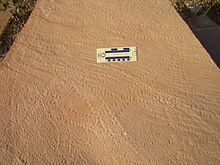Diplichnites
| Diplichnites Temporal range: | |
|---|---|

| |
| Oblique bedding plane view of large Diplichnites from the Joggins Formation (Pennsylvanian), Cumberland Basin, Nova Scotia. This trackway was made by the myriapod Arthropleura. | |
| Trace fossil classification | |
| Domain: | Eukaryota |
| Kingdom: | Animalia |
| Phylum: | Arthropoda |
| Ichnogenus: | †Diplichnites d'Orbigny, 1842 |

Diplichnites are arthropod trackways with two parallel rows of blunt to elongate, closely spaced tracks oriented approximately perpendicularly to the mid-line of the trackway.[1] The term is more often used for the ichnofossils of this description; however, similar trackways from recent arthropods are sometimes given this name as well.[2]
The Diplichnites makers
This type of trackway was originally based on large fossils from Pennsylvanian strata of Nova Scotia, when Sir J. W. Dawson named it in 1873.[3] Dawson proposed that Diplichnites were produced by a fish “walking” in shallow water on pectoral or ventral fin spines. Previous to this he had suggested that a large crustacean, annelid worm or myriapod (such as a millipede) could have made them.[4] Subsequent evidence has supported this earlier interpretation. The fossils on which this ichnotaxon was based are now thought to be from giant myriapods,[5] such as Arthropleura. The Scottish Diplichnites cuithensis could have been the result of a 1-meter-long arthropleurid walking.[6]
In the decades following Dawson's work, the trackways of several other arthropods were also included within Diplichnites – particularly, trilobites, which are known from marine Paleozoic deposits around the world. In addition, recent evidence indicates that some Diplichnites trackways from certain Cambrian intertidal and subaerial deposits of North America, especially the Potsdam and Elk Mound Groups, were produced by euthycarcinoids.[7][8] In that scenario, the Diplichnites may have been undertracks that penetrated to the underlying layer of sediment, and the fossil trackways thus produced on the top surface (preserving the impression of the dragging tail) were Protichnites.[9][10]
References
- ^ Minter et al., 1986
- ^ Davis et al., 2007
- ^ Dawson, 1873
- ^ Dawson, 1862
- ^ Briggs et al., 1979
- ^ Robert P. Lynch (1981). New Zealand Journal of Geology and Geophysics 1981. Science Information Division, DSIR. p. 639. Retrieved 2022-08-21.
- ^ Collette & Hagadorn, 2010
- ^ Collette, Gass & Hagadorn, 2012
- ^ Goldring & Seilacher, 1971
- ^ Hoxie, 2005
Further reading
- Briggs, D. E. G.; W. D. I. Rolfe & J. Brannan (1979). "A giant myriapod trail from the Namurian of Arran, Scotland". Palaeontology. 22: 273–291.
- Collette, J. H.; Gass, K. C.; Hagadorn, J. W. (2012). "Protichnites eremita unshelled? Experimental model-based neoichnology and new evidence for a euthycarcinoid affinity for this ichnospecies". Journal of Paleontology. 86 (3): 442–454. doi:10.1666/11-056.1. S2CID 129234373.
- Collette, J. H.; J. W. Hagadorn (2010). "Three-dimensionally preserved arthropods from Cambrian Lagerstatten of Quebec and Wisconsin". Journal of Paleontology. 84 (4): 646–667. doi:10.1666/09-075.1. S2CID 130064618.
- Davis, R. B.; N. J. Minter & S. J. Braddy (2007). "The neoichnology of terrestrial arthropods" (PDF). Palaeogeography, Palaeoclimatology, Palaeoecology. 255 (3–4): 284–307. doi:10.1016/j.palaeo.2007.07.013.
- Dawson, J. W. (1862). "Notice of the discovery of additional remains of land animals in the Coal-Measures of the South Joggins, Nova Scotia". Quarterly Journal of the Geological Society of London. 18 (1–2): 5–7. doi:10.1144/GSL.JGS.1862.018.01-02.10. S2CID 128483390.
- Dawson, J. W. (1873). "Impressions of footprints of aquatic animals and imitative markings, on Carboniferous rocks". American Journal of Science. 5 (25): 16–24. doi:10.2475/ajs.s3-5.25.16. S2CID 130625563.
- Garlock, T. L.; P. E. Isaacson (1977). "An occurrence of a Cruziana population in the Moyer Ridge Member of the Bloomsberg Formation (Late Silurian)-Snyder County, Pennsylvania". Palaeontology. 51: 282–287.
- Goldring, R.; A. Seilacher (1971). "Limulid undertracks and their sedimentological implications". Neues Jahrbuch für Geologie und Paläontologie, Abhandlungen. 137: 422–442.
- Hoxie, C. T. (2005). "Late Cambrian arthropod trackways in subaerially exposed environments: Incentives to simplify a problematic ichnogenus". Unpublished B.A. Thesis: 1–89.
- Minter, N. J.; M. G. Mángano & J.-B. Caron (2011). "Skimming the surface with Burgess Shale arthropod locomotion". Proceedings of the Royal Society B: Biological Sciences. 279 (1733): 1613–1620. doi:10.1098/rspb.2011.1986. PMC 3282348. PMID 22072605.
- Woolfe, K. J. (1990). "Trace fossils as paleoenvironmental indicators in the Taylor Group (Devonian) of Antarctica". Palaeogeography, Palaeoclimatology, Palaeoecology. 80 (3–4): 301–310. doi:10.1016/0031-0182(90)90139-X.
External links
Diplichnites:
- Photo--Diplichnites gouldi arthropod trackway--(marine, tidal); Article – "Bulletin 241", Kansas Geological Survey
- Photo--from Arthropleura sp; Article – "Nova Scotia, Carboniferous Geology and Paleontology"
- Video--Euthycarcinoid animation on Diplichnites slab (Milwaukee Public Museum)
Trilobite Tracks:
- Trilobite Trace Fossils – 3-main types of trilobite trace fossils
